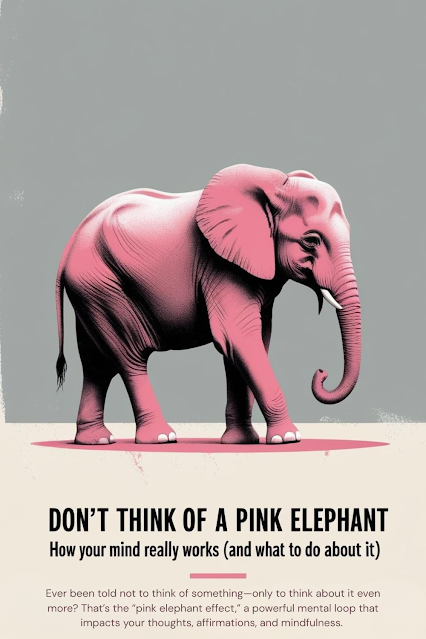Have you ever been told not to think about something… and then it’s the only thing you can think about?
Maybe it’s:
"Don't check your phone."
"Don’t mess this up."
"Don't think of a pink elephant."
…and boom. A pink elephant just strolled into your brain, uninvited, probably wearing sunglasses.
This isn’t just a silly mind game. It’s a powerful insight into how your mind actually works—and once you understand it, you can use it to your advantage. Whether you're working with affirmations, trying to stay focused, or just want some peace of mind, the pink elephant effect has something to teach you.
🧠 What Is the “Don’t Think of a Pink Elephant” Phenomenon?
The moment someone says, “Don’t think of a pink elephant,” your brain paints a big, pink pachyderm on your mental screen.
Why?
Psychologist Daniel Wegner explored this in the 1980s and coined the term ironic process theory. His research showed that when we try not to think about something, we actually end up thinking about it more.
Here’s why:
In order for your brain to monitor whether you’re avoiding a thought, it has to keep scanning for that thought—meaning it ends up bringing it to mind constantly.
❝ The more we try to suppress a thought, the more likely it is to pop up. ❞
— Daniel Wegner
So when you're lying in bed thinking, “I must fall asleep now,” or “I won’t think about that embarrassing thing I said today,”—you’re setting off that mental loop.
🧘♀️ What Mindfulness and Spirituality Say
This isn’t just psychology—it’s ancient wisdom too.
In mindfulness and Zen practices, you’re not told to suppress your thoughts. You’re taught to observe them. You let them rise, float, and pass—like clouds in the sky.
Eckhart Tolle put it beautifully:
❝ What you resist, persists. What you accept, transforms. ❞
It’s not about pushing thoughts away. It’s about noticing them without judgment, and gently letting go.
⚠️ Why We Obsess Over What We Don’t Want
Let’s get real: Have you ever tried dieting by telling yourself not to eat sweets?
And then suddenly, every billboard, bakery, and Instagram post seems to whisper, “Cake. Now.”
That’s your pink elephant, wearing frosting.
In modern life, where we’re constantly overstimulated by phones, deadlines, and mental clutter, our brains are on high alert. When we try to avoid certain thoughts—don’t stress out, don’t mess up, don’t get anxious—we end up shining a spotlight on exactly what we’re trying to avoid.
And the more emotionally charged the thought is (like fear or embarrassment), the more your brain clings to it.
✨ What This Means for Affirmations (And Why Yours Might Not Be Working)
If you’ve ever tried affirmations like:
“I’m not scared.”
“I won’t fail.”
“I don’t want to be anxious.”
…you may have noticed they don’t help much. In fact, they can make you feel more anxious or unsure.
Here’s why:
Your subconscious doesn’t process negation the way you think it does. It focuses on the main idea—not, won’t, don’t all get filtered out.
So when you say, “I’m not nervous,” your subconscious hears… “I’m nervous.”
✅ How to Write Affirmations That Actually Work
To make affirmations effective, give your mind clear, positive direction. Think of it like setting a GPS: You need to tell it where you want to go, not just where you don’t want to end up.
Here’s how to flip common negative affirmations into positive, empowering ones:
❌ Don’t Say This ✅ Say This Instead
“I don’t want to be anxious.” “I feel calm and grounded.”
“I won’t mess this up.” “I trust myself and my abilities.”
“I’m not scared.” “I am brave and steady.”
“I don’t want to be alone.” “I am loved, supported, and connected.”
The trick? Use words that evoke emotion and imagery.
Your subconscious is like a child—it responds to pictures, feelings, and repetition. So when you say something like “I am safe and strong,” your body starts to feel that reality.
🧭 Final Thoughts: Your Brain Loves Clarity
Think of your brain like a search engine or GPS system.
It needs clear directions to guide your attention.
If you tell it:
“Don’t focus on fear.”
It hears: Fear. Got it! On it.
But if you say:
“I focus on peace.”
It says: Peace. Let’s go find that.
💬 Use language that sounds like this:
“I am…”
“I feel…”
“I welcome…”
“I choose…”
“I create…”
These phrases signal intentional focus, which is exactly what your mind thrives on.
🪞 TL;DR – Don’t Think of a Pink Elephant
Telling yourself not to think about something usually makes you think about it more.
Mindfulness and awareness are more powerful than resistance.
Use affirmations that are positive, present, and emotionally vivid.
Your brain listens to what you focus on—not just what you say.
Speak to yourself like someone you love and trust.
📌 Pin This Wisdom
Your mind doesn’t follow your words. It follows your attention.
So guide it gently. Focus on what you want—not what you fear.















0 Yorumlar